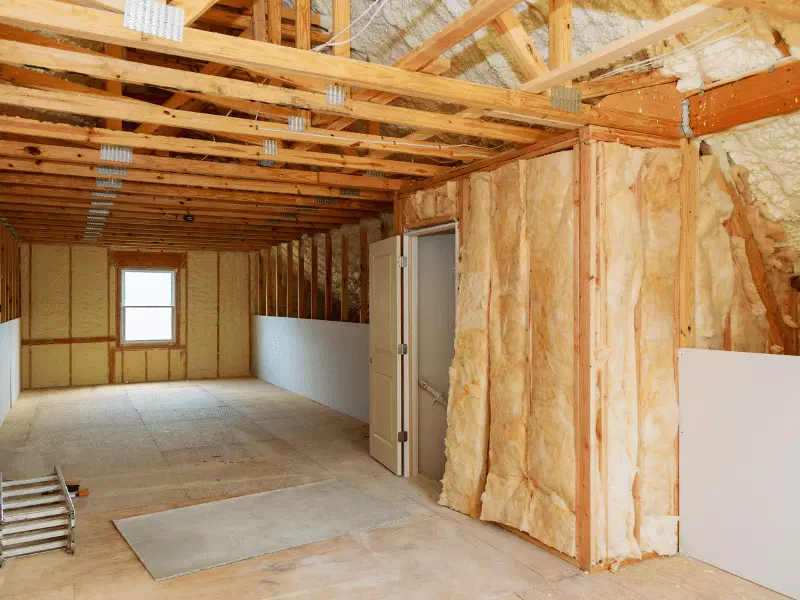
If you're constructing a new, energy-efficient home or are considering renovating your existing home to make it more energy-efficient, it's time to talk insulation.
What is Insulation, and why is it important?
In the simplest terms, insulation is a material that's placed in areas in your home where air can typically escape, for example, between wall stud cavities, the attic, crawl spaces, the basement, and so on. By acting as a barrier and preventing warm or cold air from escaping from inside to outside and vice versa, insulation keeps your home warm in the winter and cool in the summer, which saves you money on your energy bills. How much can you actually save? As much as 15% on heating and cooling costs and as much as 11% on total energy bills according to the EPA! Safe to say that whether you're a new homeowner or have owned your own home for many years, it's worth looking into the different kinds of insulation and figuring out which one works best for your home.
Different Kinds of Insulation
Before we dive into the different kinds of insulation available on the market, it's important to understand that each kind is good for a particular purpose and it's important to have a discussion with your wood framing contractor or general contractor about the pros and cons of each before proceeding.
Blanket batts and rolls:
This is the most common type of insulation and is made of fiberglass, rock wool, or natural fibers. It comes in standard widths that fit most standard wall stud and joist cavities, and you can easily cut it to size using a utility knife. This type of insulation is good for unfinished walls, floors, and ceilings in new construction as well as retrofits.
Loose-fill:
this type of insulation, also made of fiberglass, rock wool, or natural fibers, is good for hard-to-reach places like attic rafters. It's also good for areas that need to be insulated but are difficult to access, such as crawl spaces.
Spray foam:
This kind of insulation is made of two different kinds of chemicals that react when mixed together and sprayed from a nozzle. It can be used to insulate unfinished walls, floors, ceilings, and crawl spaces as well as finished walls that have been framed.
Rigid foam boards:
This type of insulation is made of compressed fiberglass, rock wool, or natural fibers. It's good for unfinished walls, floors, and ceilings as well as finished walls that have been framed.
Radiant barriers:
This type of insulation is a reflective material that's typically used in unfinished walls, floors, and ceilings to reflect heat away from the home. It's most effective in hot climates.
Blown-in Insulation:
This type of insulation is made of fiberglass, rock wool, or cellulose and is good for unfinished walls, floors, ceilings, and crawl spaces.
Rockwool:
This type of insulation is made from natural rocks that have been melted and spun into fibers. It's good for unfinished walls, floors, ceilings, and crawl spaces.
Cellulose:
This type of insulation is made from recycled paper that's been treated with fire retardants. It's good for unfinished walls, floors, ceilings, and crawl spaces.
Fiberglass:
This type of insulation is made from glass that's been melted and spun into fibers. It's good for unfinished walls, floors, ceilings, and crawl spaces.
All of the insulations options mentioned abovework by restricting air flow, or at the very least making it more difficult for air to pass through the material. There are many types of materials available, including manufactured insulation and environmentally-friendly choices. Also, some options are more appropriate for certain situations than others, such as products that are useless on vertical walls but helpful in horizontal applications. Choosing the right type of insulation is a case-by-case situation.
DIY vs Contractor Installed Insulation
You can either install the insulation yourself or hire a contractor to do it for you. If you're planning on doing it yourself, make sure you understand what type of insulation is best for your home and the tools you'll need to properly install it. You should also be aware of any safety concerns (such as working with power tools in tight spaces, health concerns when working with specific kinds of insulation, etc.) and have a plan to mitigate them. If you're hiring a contractor, get multiple bids and make sure the contractors are properly licensed and insured.
The U.S. Department of Energy (DOE) recommends that homeowners install at least R-13 insulation in their walls and R-30 in their ceilings, but the DOE also acknowledges that different climates require different levels of insulation. In general, homes in colder climates need more insulation than homes in warmer climates. The DOE also recommends that homeowners insulate their attics, crawl spaces, and any other areas where heat can escape.
There are many ways to save money by insulating your home, but the most important thing is to make sure you do it correctly. Insulation is an important part of any home, and it's something that every homeowner should be aware of. By insulating your home, you can save money on your energy bills and make your home more comfortable year-round.
